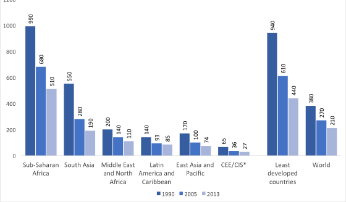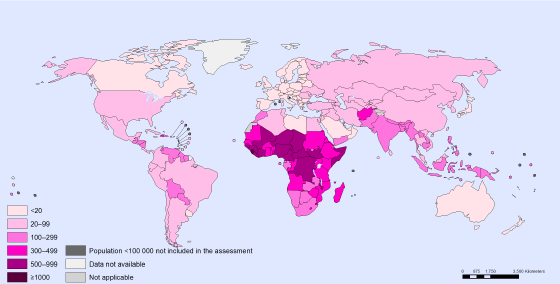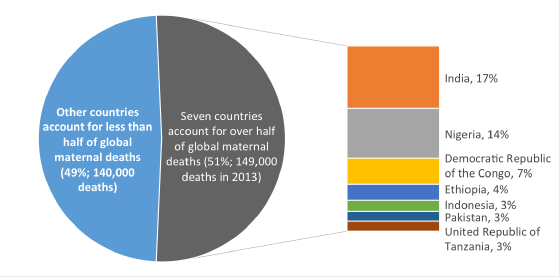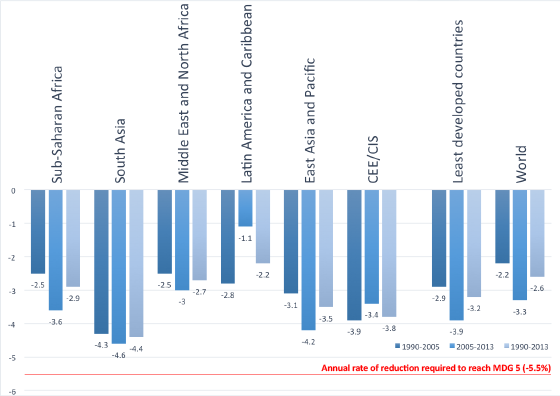The boundaries and names shown and the designations used on this map do not imply official endorsement or acceptance by the United Nations. Final boundary between the Republic of Sudan and the Republic of South Sudan has not yet been determined.
*Dotted line represents approximately the Line of Control in Jammu and Kashmir agreed upon by India and Pakistan. The final status of Jammu and Kashmir has not yet been agreed upon by the parties.
Maternal mortality has declined steadily since 1990, but not quickly enough to meet the MDG target
Maternal mortality refers to deaths due to complications from pregnancy or childbirth. From 1990 to 2013, the global maternal mortality ratio declined by 45 per cent – from 380 deaths to 210 deaths per 100,000 live births, according to UN inter-agency estimates. This translates into an average annual rate of reduction of 2.6 per cent. While impressive, this is less than half the 5.5 per cent rate needed to achieve the three-quarters reduction in maternal mortality targeted for 2015 in Millennium Development Goal 5.
Every region has advanced, although levels of maternal mortality remain unacceptably high in sub-Saharan Africa. Almost all maternal deaths can be prevented, as evidenced by the huge disparities found between the richest and poorest countries. The lifetime risk of maternal death in industrialized countries is 1 in 4,000, versus 1 in 51 in countries classified as ‘least developed’.
LEVELS OF MATERNAL MORTALITY
The number of women and girls who died each year from complications of pregnancy and childbirth declined from 523,000 in 1990 to 289,000 in 2013. These improvements are particularly remarkable in light of rapid population growth in many of the countries where maternal deaths are highest. Still, about 800 women are dying each day from complications in pregnancy and childbirth. And for every woman who dies, approximately 20 others suffer serious injuries, infections or disabilities. Almost all maternal deaths (99 per cent) occur in developing countries.
Two regions, sub-Saharan Africa and South Asia, account for 86 per cent of maternal deaths worldwide. Sub-Saharan Africans suffer from the highest maternal mortality ratio – 510 maternal deaths per 100,000 live births, or 179,000 maternal deaths a year. This is nearly two thirds (62 per cent) of all maternal deaths per year worldwide. South Asia follows, with a maternal mortality ratio of 190, or 68,000 maternal deaths a year, accounting for 24 per cent of the global total. That said, regional and global averages tend to mask large disparities both within and among countries.
Over half of all maternal deaths are found in seven countries. Among these, two countries, India and Nigeria, account for about 31 per cent of all maternal deaths worldwide. The 10 countries with the worst maternal mortality ratios are all in sub-Saharan Africa: Sierra Leone (1,100 per 100,000 live births), Chad (980), Central African Republic (880), Somalia (850), Burundi (740), Democratic Republic of the Congo (730), South Sudan (730), Côte d’Ivoire (720), Guinea (650) and Liberia (640).
TRENDS
Commitment and action at the global and country levels to end preventable maternal deaths have gained momentum. This is reflected in the acceleration of the global pace of decline in the maternal mortality ratio over the past decade. Globally, the annual rate of decline increased from 2.2 per cent over the years 1990-2005 to 3.3 per cent from 2005 to 2013. The acceleration is due mainly to increased progress in developing countries, especially in sub-Saharan Africa and East Asia and the Pacific. Despite this uptick in the pace of change, only 19 countries were found to be ‘on track’ in achieving MDG 5, according to 2013 estimates: Belarus (96 per cent reduction in the maternal mortality ratio), Maldives (93 per cent reduction), Bhutan (87 per cent), Cambodia (86 per cent), Israel (84 per cent), Equatorial Guinea (81 per cent), Poland (81 per cent), Lao People's Democratic Republic (80 per cent), Romania (80 per cent), Bulgaria (78 per cent), Estonia (78 per cent), Timor-Leste (78 per cent), Eritrea (77 per cent), Latvia (77 per cent), Oman (77 per cent), Lebanon (76 per cent), Nepal (76 per cent) and Rwanda (76 per cent).
CAUSES OF MATERNAL DEATH
Haemorrhage remains the leading cause of maternal mortality, accounting for over one quarter (27 per cent) of deaths. Similar proportion of maternal deaths were caused indirectly by pre-existing medical conditions aggravated by the pregnancy. Hypertensive disorders of pregnancy, especially eclampsia, as well as sepsis, embolism and complications of unsafe abortion also claim a substantial number of lives.
The complications leading to maternal death can occur without warning at any time during pregnancy and childbirth. Most maternal deaths can be prevented if births are attended by skilled health personnel – doctors, nurses or midwives – who are regularly supervised, have the proper equipment and supplies, and can refer women in a timely manner to emergency obstetric care when complications are diagnosed. Complications require prompt access to quality obstetric services equipped with life-saving drugs, including antibiotics, and the ability to provide blood transfusions needed to perform Caesarean sections or other surgical interventions.
LIFETIME RISK OF MATERNAL DEATH
The lifetime risk of maternal death is the probability that a 15-year-old girl will die from complications of pregnancy or childbirth over her lifetime; it takes into account both the maternal mortality ratio and the total fertility rate (average number of births per woman during her reproductive years under current age-specific fertility rates). Thus, in a high-fertility setting, a woman faces the risk of maternal death multiple times, and her lifetime risk of death will be higher than in a low-fertility setting. In 2013, the lifetime risk of maternal death in the developing world as a whole was 1 in 160, compared to 1 in 4,000 in industrialized regions. Among regions, women in sub-Saharan Africa face the highest lifetime risk (1 in 38), followed by South Asia (1 in 190). The top ten countries with the highest lifetime risk of maternal death are all in sub-Saharan Africa and include Chad (1 in 15), Somalia (1 in 18), Niger (1 in 20), Sierra Leone (1 in 21), Burundi (1 in 22), Democratic Republic of the Congo (1 in 23), Mali (1 in 26), Central African Republic (1 in 27) and South Sudan (1 in 28).
REFERENCES
AbouZahr, C., and T. Wardlaw, ‘Maternal Mortality at the End of the Decade: What signs of progress?’, Bulletin of the World Health Organization, vol. 79, no. 6, 2001, pp. 561─573.
Khan, Khalid S., et al., ‘WHO Analysis of Causes of Maternal Death: A systematic review’, Lancet, vol. 367, no. 9516, 1 April 2006, pp. 1066─1074.
Say L et al., ‘Global causes of maternal death: a WHO systematic analysis’ Lancet Global Health. http://dx.doi.org/10.1016/S2214-109X(14)70227-X, May 6, 2014.
UNICEF, Progress for Children: Achieving the MDGs with equity, Report No. 9, UNICEF, New York, 2011.
UNICEF, Progress for Children: A report card on maternal mortality, Report No. 7, UNICEF, New York, 2008.
UNICEF, WHO and UNFPA, Guidelines for Monitoring the Availability and Use of Obstetric Services, UNICEF, New York, 1997.
WHO and UNICEF, The Sisterhood Method for Estimating Maternal Mortality: Guidance notes for potential users, WHO, Geneva 1997.
WHO, UNICEF, UNFPA and The World Bank, Trends in Maternal Mortality: 1990 to 2013, WHO, Geneva, 2014.









